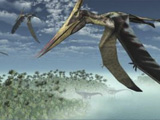|
|
TODAY.AZ / Weird / Interesting
The rise and rise of the flying reptiles: Pterosaurs not driven into extinction by birds, study reveals
09 July 2011 [09:06] - TODAY.AZ
 Pterosaurs, flying reptiles from the time of the dinosaurs, were not driven to extinction by the birds, but in fact they continued to diversify and innovate for millions of years afterwards.
Pterosaurs, flying reptiles from the time of the dinosaurs, were not driven to extinction by the birds, but in fact they continued to diversify and innovate for millions of years afterwards.A new study by Katy Prentice, done as part of her undergraduate degree (MSci in Palaeontology and Evolution) at the University of Bristol, shows that the pterosaurs evolved in a most unusual way, becoming more and more specialised through their 160 million years on Earth. The work is published in the Journal of Systematic Palaeontology.
"Usually, when a new group of animals or plants evolves, they quickly try out all the options. When we did this study, we thought pterosaurs would be the same," said Katy. "Pterosaurs were the first flying animals -- they appeared on Earth 50 million years before Archaeopteryx, the first bird -- and they were good at what they did. But the amazing thing is that they didn't really begin to evolve until after the birds had appeared."
Katy's study was done in conjunction with her supervisors, Dr Marcello Ruta and Professor Michael Benton. They looked at 50 different pterosaurs that ranged in size from a blackbird to the largest of all, Quetzalcoatlus, with a wingspan of 12 metres, four times the size of the largest flying bird today, the albatross. They tracked how all the pterosaur groups came and went through their history and recorded in detail their body shapes and adaptations.
The new work shows that pterosaurs remained conservative for 70 million years, and then started to experiment with all kinds of new modes of life. After birds emerged and became successful, the pterosaurs were not pushed to extinction, as had been suggested. It seems they responded to the new flyers by becoming larger and trying out new lifestyles. Many of the new lifestyle adaptations were seen in the pterosaurs skulls, as they adapted to feed on different food sources; some were seed-eaters, many ate fish, and later ones even lost their teeth. The rest of the body also showed a surprising amount of variation between different groups, when considering that the body forms have to retain many features to allow flight.
"Pterosaurs were at the height of their success about 125 million years ago, just as the birds became really diverse too," said Dr Marcello Ruta. "Our new numerical studies of all their physical features show they became three times as diverse in adaptations in the Early Cretaceous than they had been in the Jurassic, before Archaeopteryx and the birds appeared."
Pterosaurs dwindled and disappeared 65 million years during the mass extinction that killed the dinosaurs. In their day they had been a fair match for the birds, and the two groups divided up aerial ecospace between them, so avoiding conflict.
"We're delighted to see a student mastering some tough mathematical techniques, and coming up with such a clear-cut result," said Professor Michael Benton. "Palaeontologists have often speculated about the coming and going of different groups of animals through time, but the new study provides a set of objective measurements of the relative success and breadth of adaptation of pterosaurs through their long time on the Earth."
URL: http://www.today.az/news/interesting/89972.html
 Print version
Print version
Connect with us. Get latest news and updates.
See Also
- 19 February 2025 [22:20]
Visa and Mastercard can return to Russia, but with restrictions - 05 February 2025 [19:41]
Japan plans to negotiate with Trump to increase LNG imports from United States - 23 January 2025 [23:20]
Dubai once again named cleanest city in the world - 06 December 2024 [22:20]
Are scented candles harmful to health? - 23 November 2024 [14:11]
Magnitude 4.5 earthquake hits Azerbaijan's Lachin - 20 November 2024 [23:30]
Launch vehicle with prototype of Starship made its sixth test flight - 27 October 2024 [09:00]
Fuel prices expected to rise in Sweden - 24 October 2024 [19:14]
Turkiye strikes terror targets in Iraq and Syria - 23 October 2024 [23:46]
Kazakhstan supplied almost entire volume of oil planned for 2024 to Germany in 9 months - 23 October 2024 [22:17]
Taiwan reported passage of Chinese Navy aircraft carrier near island
Most Popular
 What von der Leyen doesn't know about. Or doesn't want to know
What von der Leyen doesn't know about. Or doesn't want to know
 Turkish auto sector shifts gears for green transformation
Turkish auto sector shifts gears for green transformation
 Bayramov: Direct talks yield better results than mediated dialogue
Bayramov: Direct talks yield better results than mediated dialogue
 Japan grants $3 billion loan to Ukraine using profits from frozen Russian assets
Japan grants $3 billion loan to Ukraine using profits from frozen Russian assets
 Baku spends over 1 billion manats on education in Q1
Baku spends over 1 billion manats on education in Q1
 America’s tariff strategy risks fragmenting global economy
America’s tariff strategy risks fragmenting global economy
 At least 148 dead after boat accident on DR Congo river
At least 148 dead after boat accident on DR Congo river
